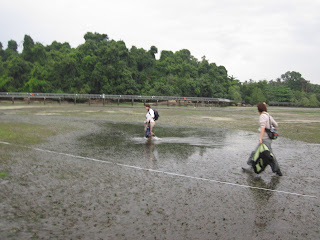To kick off our fourth year of monitoring, we will now be measuring light and temperature data in addition to our regular monitoring protocol. Light and temperature are very important factors controlling seagrass growth and health and the information collected will enhance our regular monitoring data.
In addition to light and temperature data, we will also be collecting sedimentation data for our monitoring sites. Sediment is very important for seagrass growth as it is a medium for seagrasses to anchor in. If there's severe sediment erosion, the seagrasses may eventually wash away or in cases of oversedimentation, seagrasses may be buried under if they are unable to grow fast enough to keep up with the accumulated sediment.
So on a rainy afternoon yesterday, Wei Ling and Rachel from the National Biodiversity Centre and myself set out for Chek Jawa to set up and deploy some light and temperature loggers and sediment traps for each of our two seagrass monitoring sites at Chek Jawa as a pilot study to determine if the methods and equipment we have chosen are suited to our monitoring site.

When we got to the site we had to get to work pretty quickly because the tide window was pretty short and we didn't want to be caught out at Chek Jawa in the darkness on a rising tide. The first step was to set up the monitoring site like we do during a regular monitoring session. We then divided the site into six sections like the one drawn up below:
 The site set up with dotted lines denoting the six sections within each monitoring site.
The site set up with dotted lines denoting the six sections within each monitoring site.A single sediment trap is placed at a random point within each of the six sections in the monitoring site. The sediment trap is made from a PVC pipe with a capped bottom and secured to an angle iron driven into the ground. They look something like this:
 A Sediment trap with a temperature logger attached.
A Sediment trap with a temperature logger attached.We placed a temperature logger (submersible) at the marker at the start of Transect 2 (in line with Seagrass-Watch's temperature monitoring protocol) and another two loggers with two of the 6 sediment traps in the site (as displayed above). As this is a pilot test, we did this to determine if temperature readings (taken at 30 min intervals) are more or less the same throughout the site. We also placed a submersible light logger (Odyssey Photosynthetic Irradiance Recording System) that measures the amount of light available to the seagrass. This light logger is set to record the amount of light reaching the seagrass canopy level at 30 minute intervals.
 Putting the set up together with Cable ties to make sure they aren't easily dislodged.
Putting the set up together with Cable ties to make sure they aren't easily dislodged. What the final-set up of the light (blue Odyssey logger), temperature (Hobo pendant logger) and sediment (PVC pipe) trio looks like.
What the final-set up of the light (blue Odyssey logger), temperature (Hobo pendant logger) and sediment (PVC pipe) trio looks like.There are more photos of us setting up the site (doing some heavy-duty cable-tying and hitting of stakes) but they are on Rachel's camera and I'll update this post when I get them from her. We worked pretty intensively and briskly so we were able to finish setting up two sites in under 90 minutes (albeit with sore arms from hitting all those stakes) and we headed back to land tired and hungry (and all set for a big dinner at Changi Village).
The loggers and sediment traps will be left out for two weeks, afterwhich we will collect them and have a look at the data and make further refinements to the method if need be. For future sessions, the plan is to deploy the loggers and traps two weeks before and after each monitoring session - which means 4 weeks worth of information around each monitoring period.

Stay tuned for more photos! :)

No comments:
Post a Comment